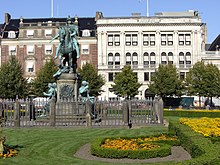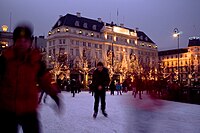Kongens Nytorv
 Kongens Nytorv | |
| Location | Indre By,Copenhagen,Denmark |
|---|---|
| Postal code | 1050, 1051 |
| Nearest metro station | Kongens Nytorv |
| Coordinates | 55°40′49″N12°34′9″E/ 55.68028°N 12.56917°E |

Kongens Nytorv(lit."The King's New Square" ) is apublic squareinCopenhagen,Denmark,centrally located at the end of thepedestrian streetStrøget.The largest square of the city, it was laid out byChristian Vin 1670 in connection with a major extension of the fortified city, and has anequestrian statueof him at its centre. The initiative moved the centre of the city from the medieval area aroundGammeltorv,at that time a muddy medievalmarketplace,to acobblednew square with a garden complex, inspired by the Royal city planning seen inParisfrom the early 17th century.[1]
Important buildings facing the square include theRoyal Danish Theaterfrom 1874, theCharlottenborg Palacefrom 1671 (now theRoyal Danish Academy of Fine Arts), theThott Palacefrom 1683 (now theFrench Embassy), theHotel D'Angleterreand theMagasin du Norddepartment store.
History[edit]
New Copenhagen[edit]
In the beginning of the 17th century, the area later to become Kongens Nytorv was located outside theFortifications of Copenhagen,as the eastern section of the ramparts,Østervold,ran along the western edge of the current square, with the eastern city gate,Østerport,located at the end of the streetØstergade.Outside the gate, an undulating terrain extended towards the sea. As part ofChristian IV's ambitious plans to strengthen Copenhagen as a regional centre, he wanted to double the area of the fortified city, he acquired 200 hectares of land outside Østerport in 1606. To protect the new city district, calledNew Copenhagen(Danish: Ny København) orSaint Anne's Town(Danish: Sankt Annæ By), he started construction of aredoubt,Saint Anne's Post(Danish: Sankt Annæ Skanse), at the site later to become Kastellet. In 1627 acustoms housewas added at the site. In the beginning of the 1640s the old Østervold was abandoned altogether in favour of the new ramparts further north, and the location of the King's new square, Kongens Nytorv, was decided in 1647 with the construction of the streetGothersgadein 1647. According to a masterplan from created by the fortification engineer Axel Urups, Kongens Nytorv was to be connected to the sea by a canal.[1]
Creating the square[edit]

At this time, under the reign ofFrederik III,the site was a chaotic area, dominated by remains of the old ramparts and piles of garbage, almost made unpassable when wet weather transformed it into a muddy morass. Due to the topography and obstructed character of the premises, the site was popularly known asHallandsåsen,a reference to thehorstby the same name which had to be traversed when traveling fromScaniaandHalland.[1]
Shortly after Christian V was crowned in 1670, he decided to level and cobble the square. This decision was taken mainly for military reasons, its strategic location with almost the same distance to all points along the ramparts of the city making it well suited as a central alarm square. At the same time, the square was to serve as aplace royalewith inspiration from France.[2]
Early buildings[edit]

Land around the new square was distributed among interested wealthy citizens, including people from the new ranks. Buildings facing the square were required to be in at least two stories and meet certain standards.Ulrik Frederik GyldenløvemChristian V's half-brother, completed hisGyldenløve Mansionon the square in the mid-1780s. AdmiralHenrik Bjelkeconstructed another town mansion on the square in the 1670s. It was in 1721 acquired byUlrik Adolf von Holsteinand was from then on known as the Holstein Mansion (Danish: Holsteins Palæ).[3]TheJuel Mansionwas completed for the naval officerNiels Juelin 1683.Carl Christian von Gramwas also the owner of a town mansion of the square.
In 1688, aBaroque gardencomplex with trees around a parterre and a gilded equestrian statue of Christian V in its centre, was inaugurated. In 1747 the entire square was rebuilt byFrederik Vas a military drill and ceremony ground for the King's troops until 1908, where the square was re-shaped into its original design.
Features[edit]
Equestrian statue[edit]

Theequestrian statue of Christian Vwas created by the FrenchsculptorAbraham-César Lamoureux.Dating from 1688, it is the oldest equestrian statue inScandinavia.[1]Originally made ingildedlead,it was recast inbronze1939.
With direct inspiration from the equestrian statue ofLouis XIIIerected at the centre ofPlace des Vosgesin Paris in 1639,[1]it depicts the king dressed like aRoman imperatorwith aLaurel wreathedhelmet.
At the foot of theplinth,Lamoureux placed fourallegorical statues.Facing Charlottenborg Palace stand figures ofMinervaandAlexander the Great,representingprudenceandfortitude,while the opposite side features statues ofHerkulesandArtemisia,personifications ofstrengthandhonour.
Even though Lamoureux depicted the horse in atrot-likegait,with inspiration fromMarcus Aurelius' horse at theCapitoline Hill,the design caused severe problems due to the soft metal used for the casting. The construction therefore had to be strengthened, and Lamoureux introduced a figure of a naked man crouched underneath the horse's hoof, personifyingenvybut in the same time affording support for the horse's barrel as the weakest point of the statue. However, over the centuries the problems with the statue continued, particularly with the horse's front left leg, and finally ProfessorEinar Utzon-Frankfrom theDanish Academy of Fine Artswas commissioned to recast the statue in bronze. This happened from 1939 to 1942 and the new cast was inaugurated on 22 May 1946.
Krinsen garden complex[edit]
Krinsenis an old form of the Danish word Krans, meaningcircleorwreath.It is anellipticalparterresurrounding the statue of Christian V. The ellipse was a favoured geometrical shape at the time, an obvious example bing the elliptical pattern in the paving around the Marcus Aurelius statue atPiazza del Campidoglio.Around the parterre, two rows of trees were planted. In 1711, the garden complex was remodelled, before it was given up in 1747 the garden was removed to make room for military drills, with some of the trees being dug altogether up, leaving only the equestrian statue. Some of the trees were dug up and reused for the establishment of the avenue Østre Allé. New rows ofelm treeswere planted around the statue in 1855–56, but by 1998 they were dying fromDutch elm diseaseand removed. In 2001, 80lime treeswere planted as part of a major refurbishment of the square.

Old kiosk[edit]
On the square stands an old kiosk and telephone stand from 1913. It is built inBaroque Revival stylewith a copper-clad roof and hand-carved ornamentation. It also used to offer the firstpublic telephonic connectionin Copenhagen from where it was possible to call every day except Sunday from 10 am to 8 pm.[2]Today it houses a small café with outdoor service.
Surrounding buildings[edit]
Nyhavn to Holmens kanal[edit]
Built 1672–1683,Charlottenborg Palaceis the oldest building on the square. It is now home to theRoyal Danish Academy of Fine Artsas well as the exhibition spaceKunsthal Charlottenborg.
TheHarsdorff House(No. 3-5,) was built in 1780 to design byCaspar Frederik Harsdorff.The building's facade was to serve as a model for the many master builders of the time who had little or no academic training.
TheRoyal Danish Theatre's current building (No. 1) is from 1872 to 1874 and was designed byWilhelm Dahlerup.ItsArt Nouveau-style 1931 extensionStærekassen,which spans the street Tordenskjoldsgade, was built both as an extension of the theatre and a new home forDanmarks Radio.
Nyhavn to Gothersgade[edit]
TheThott Mansion(No. 4) is from 1683 and is now home to theFrench Embassy.No. 8 was built forA. P. Moller-Maersk Groupin 10+9 and the shipping company was headquartered in the building until 1979.Jyllands-Posten's Copenhagen office was then based in the building until 2010.
TheLihme House(No. 18) is from 1787.
Gothersgad to Holmens Kanale[edit]
No. 26 was built for theGreat Northern Telegraph Companyin 1898. The company was headquartered in the building until 2008. The building is from 1767.Hotel D'Angleterre(No. 34) is one of the oldest and most prestigious hotels in Copenhagen. The current building is from 1874)
Magasin du Nord(No. 13), a leading department, opened in 1893–94.Hviids Vinstue(No. 19) is the oldest tavern in Copenhagen.
Use[edit]

Outdoor exhibition space[edit]
The square is frequently used as an open-air exhibition venue, especially for photo exhibitions.
Ice skating rink[edit]
In winter a 2,200 m2(23,681 sq ft) circularice skating rinkis constructed around Krinsen. Skating is free of charge and ice skate rental is available.
High school graduation celebrations[edit]
As an old tradition, graduating high school students from the Copenhagen area, when they graduate in June, come to Kongens Nytorv in buses, trucks or horse wagons to dance and run around Krinsen, throwing theirgraduation capsinto the air, celebrating their graduation.
References[edit]
- ^abcde"Kongens Nytorv".Selskabet for Københavns Historie. Archived fromthe originalon 2007-10-22.Retrieved2009-08-25.
- ^ab"Kongens Nytorv".Copenhagen Portal.Retrieved2009-08-25.
- ^"Tillykke til den gamle dame på Kongens Nytorv: Magasin du Nord fylder 150 år".Copenhagen kbh.Retrieved2009-08-25.
Bibliography[edit]
- Hartmann, Sys; Hartmann, Godfred (1988). "Bind 5: Kgs. Nytorv, Rosenborg og Nyboder". In Bramsen, Bo (ed.).København, før og nu - og aldrig(in Danish). Copenhagen: Forlaget Palle Fogtdal.ISBN87-7248-033-5.

